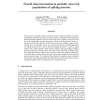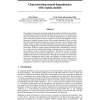12 search results - page 1 / 3 » Neural characterization in partially observed populations of... |
NIPS
2007
13 years 6 months ago
2007
Point process encoding models provide powerful statistical methods for understanding the responses of neurons to sensory stimuli. Although these models have been successfully appl...
BIOSYSTEMS
2007
13 years 4 months ago
2007
Most neural communication and processing tasks are driven by spikes. This has enabled the application of the event-driven simulation schemes. However the simulation of spiking neu...
BC
2002
13 years 4 months ago
2002
Synchronously spiking neurons have been observed in the cerebral cortex and the hippocampus. In computer models, synchronous spike volleys may be propagated across appropriately co...
NIPS
2008
13 years 6 months ago
2008
The coding of information by neural populations depends critically on the statistical dependencies between neuronal responses. However, there is no simple model that can simultane...
ISCAS
2006
IEEE
13 years 10 months ago
2006
IEEE
Abstract—We present a silicon neuron that uses shunting inhibition (conductance-based) with a synaptic rise-time to achieve synchrony. Synaptic rise-time promotes synchrony by de...


